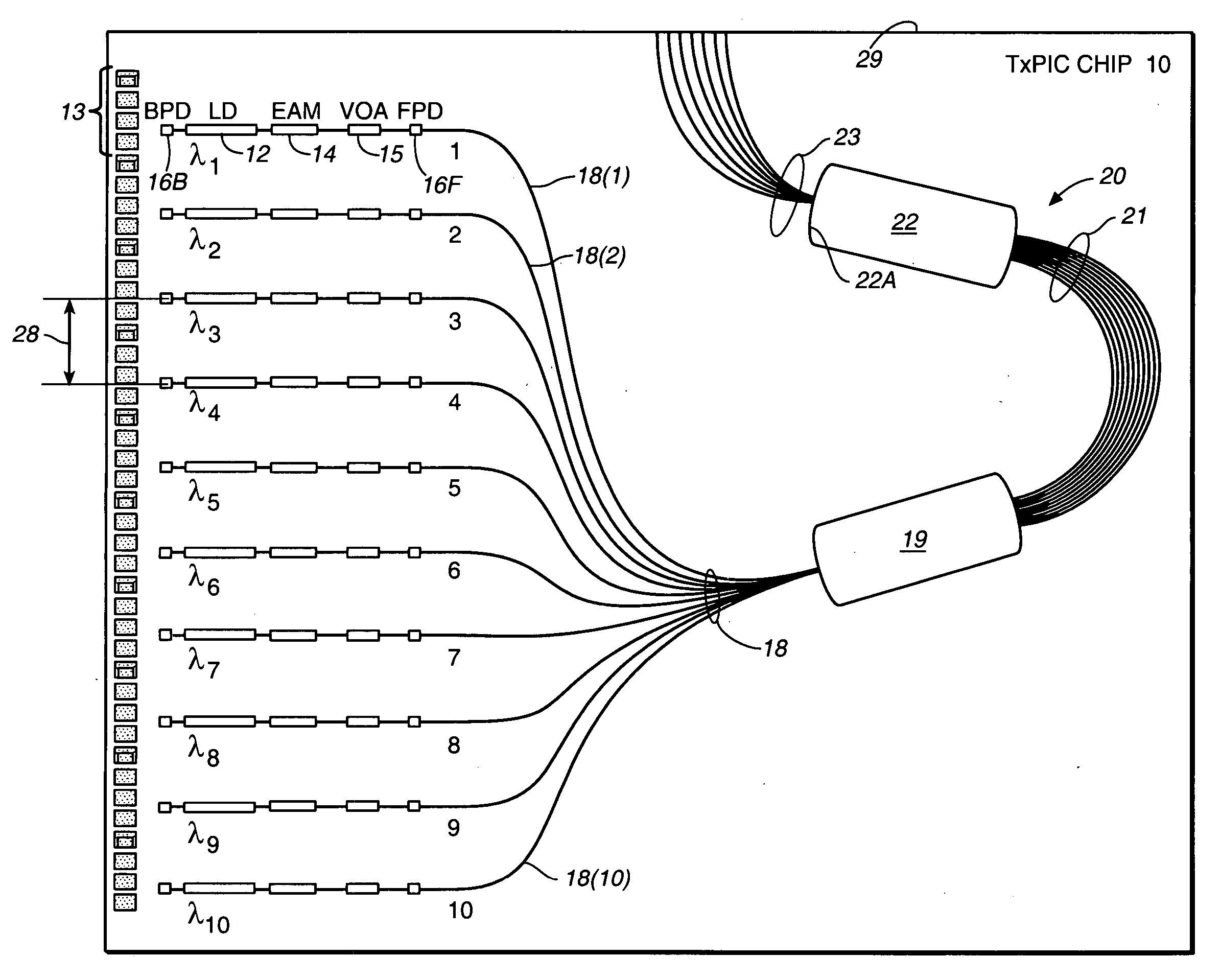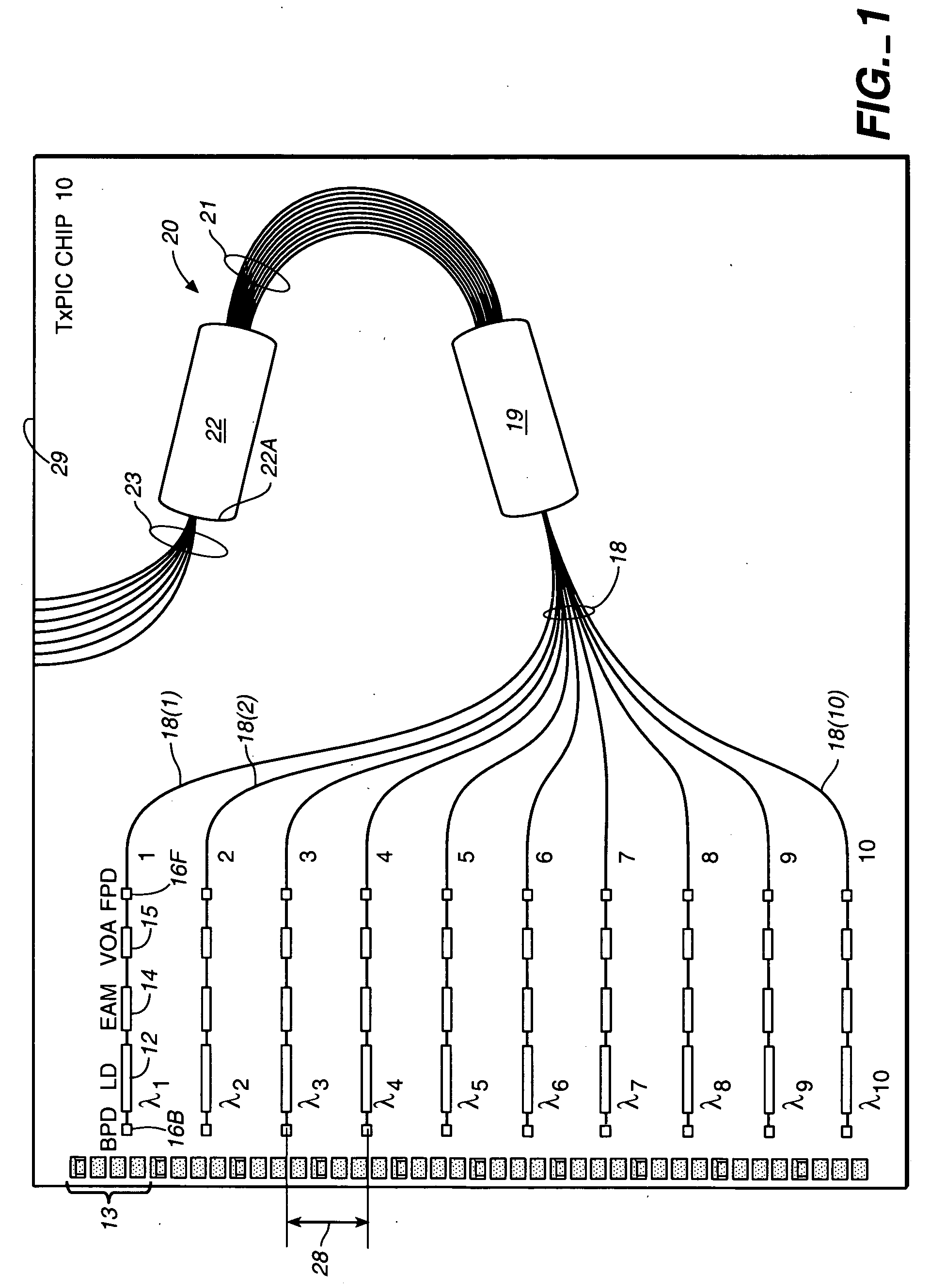Deployment of electro-optic amplitude varying elements (AVEs) and electro-optic multi-functional elements (MFEs) in photonic integrated circuits (PICs)
a technology multi-functional elements, which is applied in the field of photonic integrated circuits, can solve the problems of limiting the overall reach of the optical transmission system, the performance of the optical transmission network or optical transport system, and the optical signal-to-noise ratio (osnr), so as to improve the optical isolation of the laser source, avoid possible waveform degradation, and improve wavelength stability
- Summary
- Abstract
- Description
- Claims
- Application Information
AI Technical Summary
Benefits of technology
Problems solved by technology
Method used
Image
Examples
second embodiment
[0062] Reference is now made to the second embodiment shown in FIG. 2 comprising TxPIC chip 10A which is identical to FIG. 1 except the electro-optic amplitude varying element (AVE) shown here in the form of variable optical attenuator 15 is illustrated as positioned in each signal channel between laser source 12 and electro-optic modulator 14. A primary reason for placing VOA 15 before modulator 14 is that, placed in the position as illustrated in FIG. 1, VOA 15 may possibly degrade the Q quality or provide a Q penalty to the modulated signal output from modulator 14 including possibly some phase change to the signal. More will be said about this in connection with the embodiment shown in FIG. 10. Again, the system control circuit 40 may be employed in FIG. 2 as well as in other described embodiments to provide for pre-emphasis in the manner described in connection with that figure.
first embodiment
[0063] Reference is now made to a third embodiment of this invention in FIG. 3 comprising TxPIC chip 10B which is the same as the first embodiment in FIG. 1 except that the electro-optic amplitude varying element (AVE) illustrated here is a semiconductor optical amplifier (SOA) 19 placed in each signal channel 1 to 10 after modulator 14. The function of SOA 19 is to provide equalization across the array of λ1-λN channels by amplifying those modulated signals that are below a desired power level or to apply gain to N−1 channel signals as necessary to increase the signal gain to that of the naturally highest gain signal channel. It should be noted that with an SOA 19 or a VOA 15 provided after modulator 14, these amplitude varying elements (AVEs) may add an additional chirp to the channel modulated signal which may, in some cases, be used advantageously to predistort the signal to achieve some dispersion compensation toward improving the BER at the optical receiver across the optical ...
third embodiment
[0064] Reference is now made to a fourth embodiment of this invention shown in FIG. 4 comprising TxPIC chip 10C which is the same as the third embodiment in FIG. 3 except that semiconductor optical amplifier (SOA) 19 placed in each signal channel before modulator 14. Care must be taken in the implementation of this embodiment that SOA 19 is not sufficiently biased as to place modulator 14 into saturation. More is said about this embodiment later on in connection with the embodiment of FIG. 11.
PUM
 Login to View More
Login to View More Abstract
Description
Claims
Application Information
 Login to View More
Login to View More - R&D
- Intellectual Property
- Life Sciences
- Materials
- Tech Scout
- Unparalleled Data Quality
- Higher Quality Content
- 60% Fewer Hallucinations
Browse by: Latest US Patents, China's latest patents, Technical Efficacy Thesaurus, Application Domain, Technology Topic, Popular Technical Reports.
© 2025 PatSnap. All rights reserved.Legal|Privacy policy|Modern Slavery Act Transparency Statement|Sitemap|About US| Contact US: help@patsnap.com



